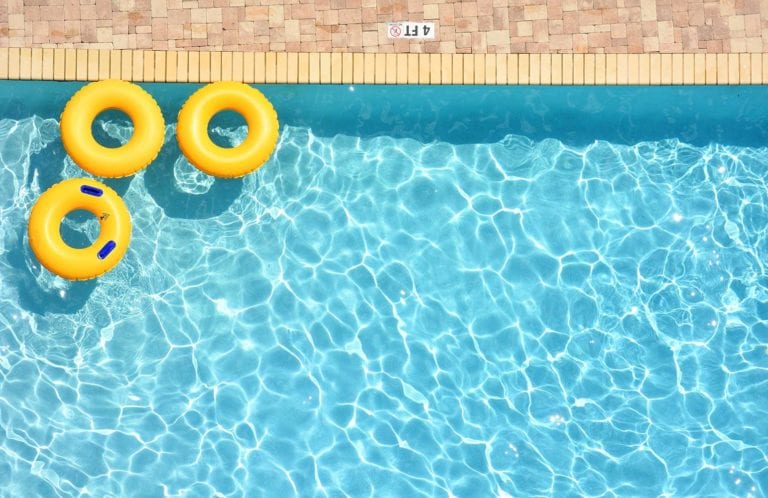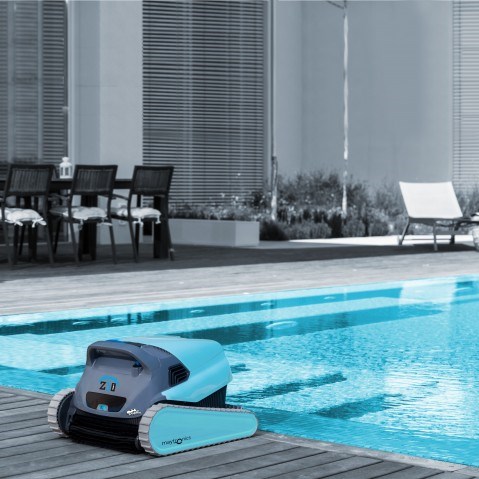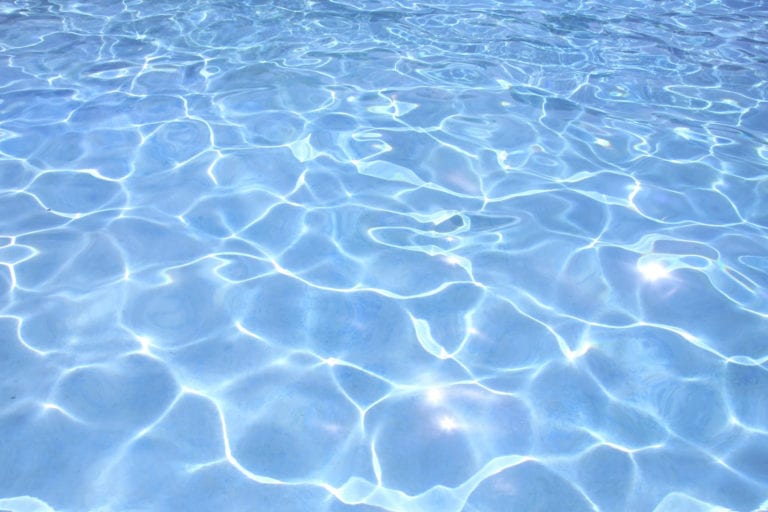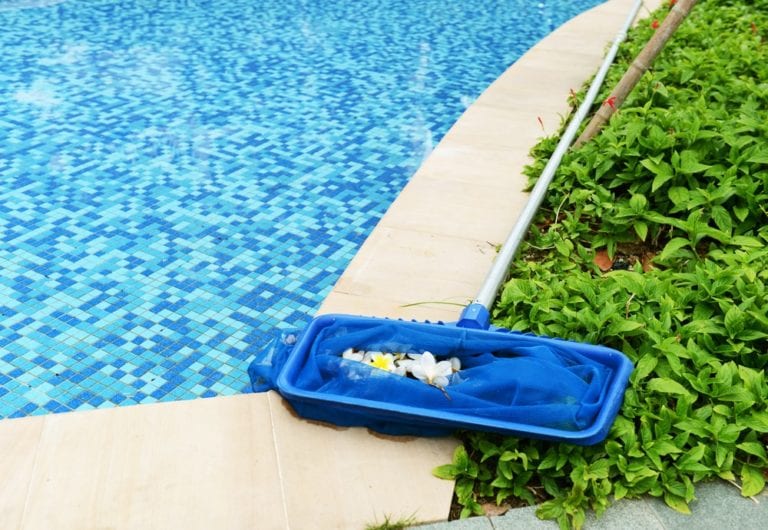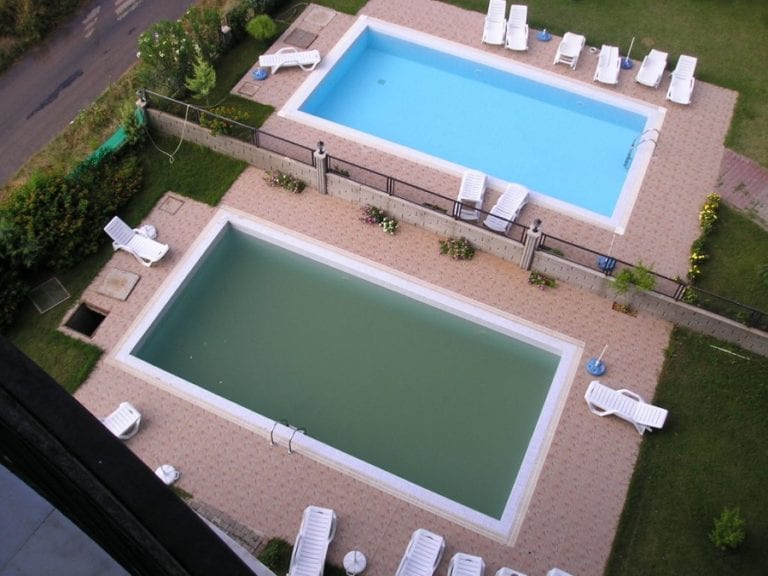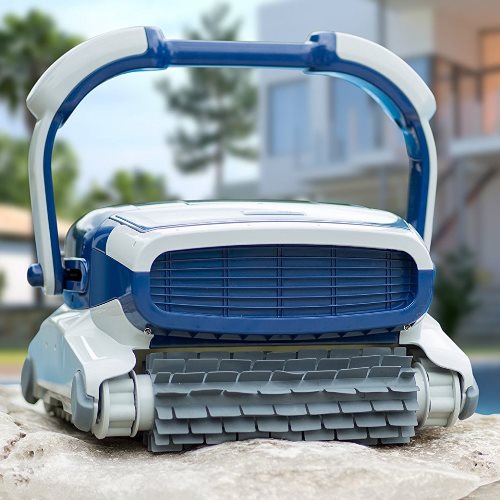7 Best Pool Heaters of 2019 | Best4YourHome’s Top Rated Pool Heaters
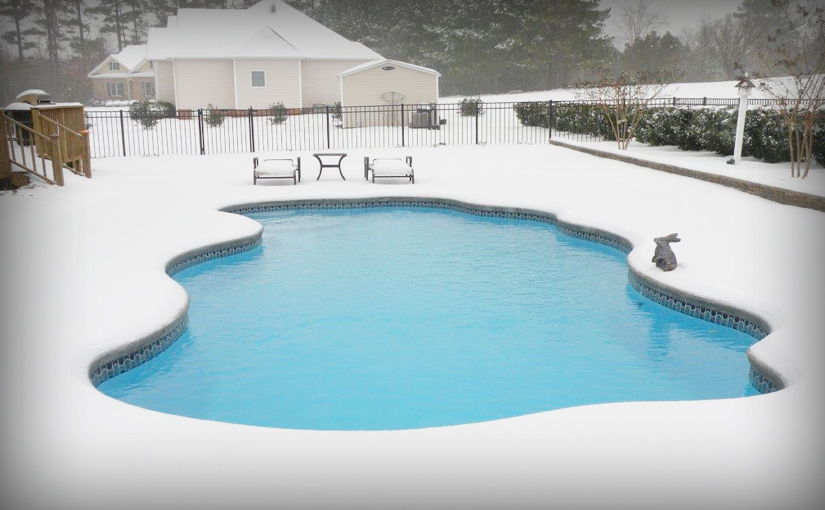
Outdoor pools are great to have, but when the days turn cooler, then consider looking for the best pool heater that allows you to keep on swimming outside during the fall season. There is nothing better than cooling off in your pool during a hot day, or in the evening, when you can relax and gaze at the stars as they appear one by one in the night sky. During cooler days, you can still enjoy swimming in warm water, even if the temperature is cooler and you normally would no longer be swimming in your pool. Just be sure to wrap yourself up when you get out, an important reminder for both children and the elderly who can be susceptible to chills.
Swimming is great exercise too, leaving far less impact on the body than running laps around a track, or jogging down a hard-surfaced road and back. So, you want to extend those days of exercise for as long as you can before you turn to using an indoor pool at a spa or gym, unless you can get an indoor pool built in your home. But where do you even start figuring out what is the best pool heater to use for your circumstances? First, let us look at the current available options, including pros and cons for using any one of these options. Here’s a quick list of our top 7 heaters
[table id=228 /]
Finding the Best Pool Heater: Gas Pool Heaters
Do you already have gas service to your home for your stove and, possibly, for your fireplace? If yes, then you can use a gas pool heater and have one installed without too much trouble. It will also cost less overall to install than an electric heater but may cost more to run over time. Gas pool heaters are efficient and run consistently, but your gas bill may be substantially affected, especially when prices fluctuate in the marketplace. You can also check on using propane heaters instead, if you currently do not have natural gas service. Remember that all gas heaters (gas generators too) should always be placed outside where they are properly ventilated.
Gas pool heaters are used most often to heat pools today, particularly as they heat the water faster than any of the other heaters, such as pump or electrical heaters. The basic process is that the gas heater pump draws water from the pool, passes it through a filter, then to the heating system. Burning gas in the combustion chamber generates more heat, transfers the heat to the water, and sends it back into the pool water. Gas pool heaters are also very effective in not only heating the water to desired temperatures quickly, but also keeping the temperature constant, regardless of the weather and climate, according to the U.S. Department of Energy (DOE).

When you begin looking at gas (and heat pump) pool heaters, you will look for the rating of each as British Thermal Unit or BTU. This is how thermal, or heat energy is measured. One BTU represents the energy output used to raise the temperature of one pound of water at sea level, by one-degree Fahrenheit. You also see this rating on air conditioners and furnace heaters, although for air conditioners, the BTU stands for how much energy is used to reduce heat, rather than raising it.
The best way to calculate the gas (and heat pump) size for your pool, comes from the Department of Energy (USA) and should give you the most exact outcome for an educated decision.
First, decide what your favorite water temperature is when you swim in your pool. Then, figure out what the average temperature is for the coldest month of pool use. This may be in May, depending on where you live, or it could be in September or October. Now, you will subtract the coldest month’s average temperature from your desired pool temperature, which is higher than the coldest month. The result is what your temperature rise will be to reach your preferred temperature.
Related: Best Solar Pool Cover
Calculate the square footage of your pool’s surface area, length by width. Depth does not count. The last step is to take your pool’s square foot calculation, multiply that number by the temperature rise you need, to get to your desired swimming temperature, and multiply that result by 12. This formula bases the result on one degree to 1.4 degrees Fahrenheit (F) temperature rise over one hour, with a 3.5 mph wind average over the surface of your pool water. If you want to raise the heat faster over an hour, you can calculate it by 1.5 degrees F, multiplied by 1.5, or 2 degrees F multiplied by 2.0. Simply stated, the formula is: pool area x temperature rise x 12.
Gas pool heaters are tested for energy efficiency by a ratio of available output to energy input. So, an 80 percent heater’s efficiency will use $80 of usable heat out of $100 worth of fuel. This means that 20 percent of the fuel is wasted. Therefore, you want to find a gas heater that maximizes your fuel at the highest percentage rating, such as 95 percent efficiency. For more information on this, go to the DOE site here.
The cost of buying a gas pool heater may be almost half of what it costs to buy an electric pool heater. It will also be the same difference in installing it. But, you may make up for that difference with higher monthly gas bills. How fast your pool water heats up when it concerns an outdoor pool, will also be dependent on where your pool is placed on your property, and for how long the sun also shines on the water, giving natural heat during the daytime. That will change how hard the pool heater must work to reach the temperature you have set for it.
While many outdoor pools are built in the ground, others are built above ground, thus avoiding having to dig a hole in your backyard. You would just need to add the holes on the side of your above ground pool, where your heating unit’s pipes/fixtures will access the interior fixtures of the pool. Generally, these gas heaters are smaller units and they are designed to sit outside on a solid platform, such as a cement block, and are capable of withstanding heavy weather and drastic temperature changes.
Consider how and where you will place a gas pool heater, when you think about high winds, for example. While you do need proper ventilation, you also want to block heavy winds from damaging your unit, due to flying debris that might cause dents or other damages. You can install a well-ventilated casing unit, something like a steel fence unit that surrounds it, but still stays in place during heavy winds. You can also add a solid latch-down or removable top cover to protect against occasional hail storms and heavy snowfalls.
Heat Pumps
Heat pump processes may sound complicated when one describes the process of providing heated water to the pool. Essentially, the pool pump circulates water in the pool, and as the water is drawn from the pool, it passes through a filter and the pump’s heater.
The pump’s heater fan, meanwhile, continuously draws air from the outside, directs that air over the evaporator coil which absorbs the air’s natural heat, and the coil’s internal refrigerant (Freon) creates a heated gas. This gas then goes through the compressor where it is heated further, then travels through the condenser, where the gas heat is sent to the pool water. If it is cold outside, the pump must work hard to achieve the given heat setting, so the best outdoor efficiency temperature should be 40 degrees and above. However, these heat pumps are more efficient than gas heaters, and they have a longer life span as well, up to 10 years in some cases. You can also look for dual operation water pumps that both heat and cool your pool water, as desired.

When you decide on using a heat pump for your pool, you would need to know the exact surface area of your pool, plus your pool’s water temperature and the typical temperature outside when you are using the pool. You should also know the wind exposure, humidity levels, and daily temperatures, including those in the evening.
Of course, all these things change with the seasons as well, so these numbers and surrounding environment will vary over time. If you live in a location that has little humidity and is cool at night, along with moderate wind gusts, then you would need a bigger heater than if you lived in a humid area that stayed warm in the evenings and had little to no wind gusts or light breezes. The usual sizes you will see for heat pumps are 3.5 hp (horse power)/75,000 BTU, 5 hp/100,000 BTU, and 6 hp/125,000 BTU.
Related: Best Pool Cleaner
When you are looking at different heat pumps, you will also see a label for COP rating. This is the Coefficient of Performance of the pump, and a higher number means a more efficient rating. This is decided by tests that the manufacturers conduct and, typically, the test is done with a heat pump pool heater at an outdoor 80 degrees F temperature, with pool water at 80 degrees F. A COP can be 3.0, up to 7.0, which translates to 300 percent to 700 percent efficiency. Each unit of electricity used in running the pump compressor, stands for 3 to 7 units of heat created. You can find out more here at the DOE website.
While you can install the heat pump pool heater yourself, you may prefer a pool professional do the installation, and then call in an air conditioner technician to support the system at least once a year. Heat pump heaters will cost more than gas heaters, but the savings comes in the annual operating fees, making them very efficient.
Electric Resistance Pool Heater
Electric pool heaters, while cheaper to buy and install, will cost you more money during monthly to annual use, as compared to a pump heater. The big plus here is that you do not get the carbon dioxide emissions you get with gas heaters. However, the installation can cost a lot because of the wiring and installation of large-amperage circuit breakers to handle that load.
Electric resistance pool heaters use a system of applying the heat of an electrical current to a metal resistor, that is extended throughout the unit. As the water passes through the unit, it is heated up to the designated temperature and then passes back out into the pool (or spa). The way to look at this, comparatively, is that electric heaters generate heat while heat pumps capture and transfer heat from the air or water. Heat pumps use electricity but not in the way that electric heaters do, hence the differences in long-term costs. Also note that while heat pumps can last a long time, the life span for most electric and gas heaters are between five to 10 years.
Solar pool heaters
These are popular in areas where the sun shines consistently, typically in warmer climates. This system also works with the pool circulation pump and, therefore, does not add to operational costs. Water travels through the solar collectors of your solar heater, runs through the pipes and goes back into the pool, heated.
The down side to using a solar heater is the high expense of the initial purchase, roughly between $4,000 to $7,000, and higher. Currently, solar panels are installed to collect the sun, and they can take up quite a bit of space. Over time, we may see a reduction of space waste, as technology advances and figures out how to reduce collection space, and yet still collect more sun.
Additionally, solar heaters take longer to heat the pool water, and cannot heat water at night. Yet, this system is environmentally friendly, and it can last for 25 years. Consider adding a heat pump to your overall heating system, so that you can have warm water at night. As the solar heating system takes care of warming your water during the day, the water will still be warmish closer to evening, and the heat pump system can take over.
When you choose a solar collector heating system for your pool, it should equal between 50 percent to 100 percent of your pool’s surface, according to the DOE website. The example used for figuring out the size is, if you had a 20-by-40-foot outdoor swimming pool, located in Florida, then you would use 800 square feet of solar collections at 100 percent of the pool’s square footage. Be sure your pool pump is also up to the task of circulating the water through the solar heat system.
Related: Best Pool Floats
Make sure your solar pool heater collectors are placed to gather the most amount of sun during the day with little to no obstruction, such as being in the shadow of another building or tall trees. You may need to tilt the collectors, so long as sun directly hits them throughout the day with a horizontal directional path. If the sun is crossing over the top of the roof where the collectors are, then laying them flat is the better plan.
You can calculate the solar collector thermal performance rating by BTUs per square foot daily, and the formula looks like this: BTU/(ft2day). You can also use megajoules (MJ) per square meter daily: MJ/(M2day). What you want to look for, as weather conditions and other factors may affect ratings, is that each collector can be rated individually, such as using solar mats. If you find that two mats are within 25 BTU/(ft2day) of each other, then they are running at the same capacity. You can check out more information here.
Added enhancements you can look at when using a solar heating pool system is using floor return lines where the heated water is dispersed to the bottom of the pool (instead of the surface), whereupon the heat travels upwards to the surface, warming cooler water at the bottom and middle areas, along the way. Also use a solar cover when the pool is not being used, to retain heat in the pool, and expending less during the nighttime hours. While this total system may be a heavy expenditure at the beginning, using both systems would be your most efficient energy system to use to get enjoyment out of your pool. As with any system, be sure you are following any local building codes and regulations. Now, we look at seven of the best choices we found that will fit any scenario you might have.
Above Ground Pool Heater, Hayward Pool Heaters & More of the Best Pool Heater Options
#1. Hayward H400FDP Universal H-Series 400,000 BTU Pool and Spa Heater, Propane, Low Nox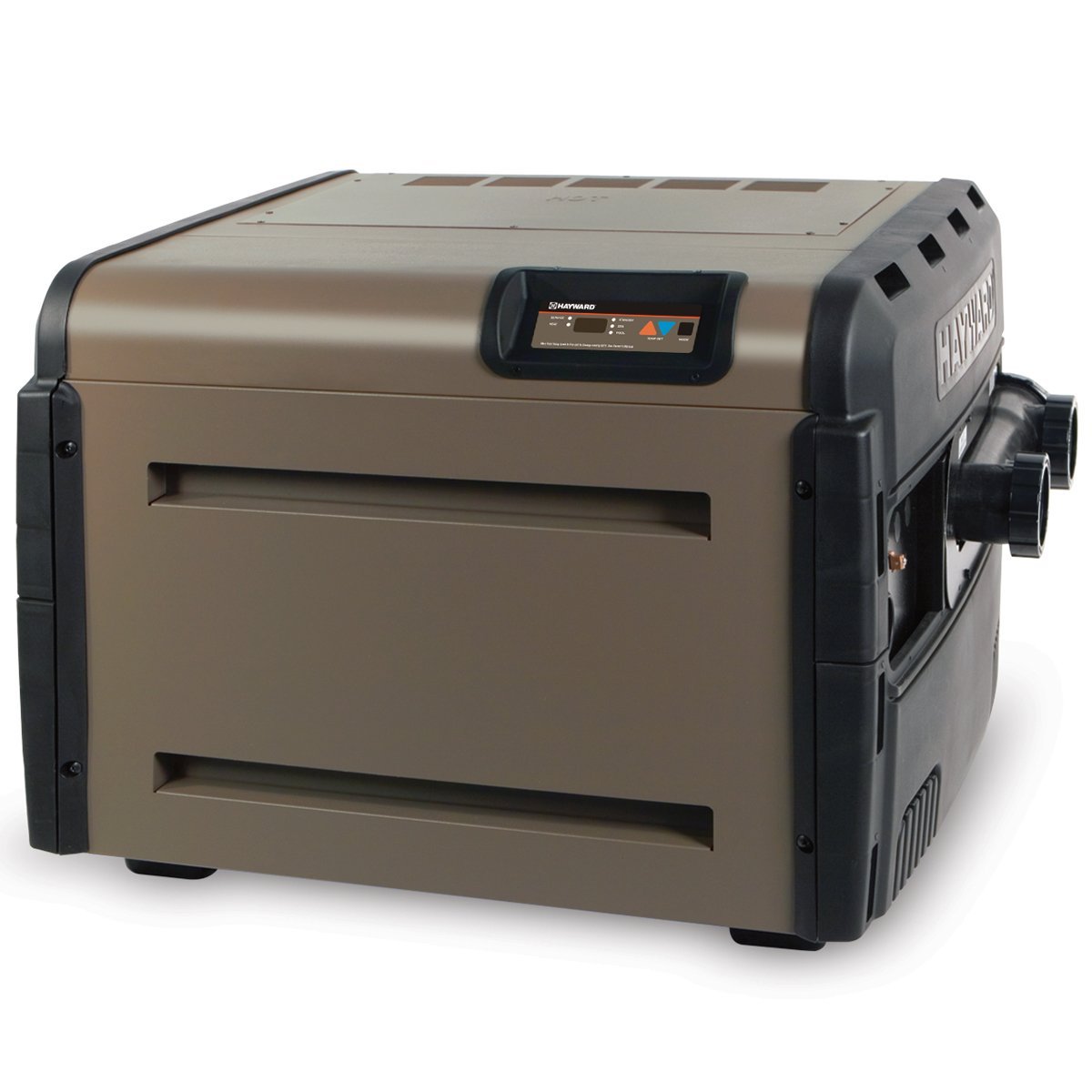
The Hayward H400FDP propane pool and spa heater has a patented polymer header design that gives superior hydraulic operations and is a top energy saver. It is designed to prevent any erosion due to high flow conditions, improving on reliability. Hayward pool heaters use only high resilient Cupro Nickel, an alloy of copper and nickel (3:1 ratio), for its heat exchangers, making the system capable of working in salt water, high flow water or under strong water chemistry conditions. It is a self-contained forced draft combustion system unit, unaffected by outdoor weather, such as high winds. The temperature is easy to set with its LED control panel, that digitally shows current temperatures accurately and consistently, and gives an electronic lockout at the set temperature and includes diagnostic status readings.
This Hayward Universal H-Series of propane gas heaters give 18 percent or more in energy savings and runs at 83 percent efficiency at 400,000 BTUs. This heater is very low in nitrogen oxide (NOx) emissions, making the unit very safe to run for long periods of time. As with gas and propane heaters, these should always be installed outdoors to avoid any potential poisonous emission buildup in an enclosed area. This is one of the best above ground pool heater units available.
Model #: H400FDP
Size: 37 x 32 x 29.3 inches
Weight: 197 pounds
Efficiency: 83 percent at 400,000 BTUs
Price: $2,113. 93 plus free shipping (Prime or not)
What Buyers Say
Over 493 customers have rated this unit, and it has four stars to date. Note that you may need to check your gas regulator to make sure you can add this heater to your house and billing. One customer in the Q + A section said she needed a larger gas regulator, according to her service provider. This is also important because if the regulator is too small, one of the heaters, house or pool, when both are run at the same time, can be starved of gas. You may also need a 1-inch pipe rather than a ¾-inch pipe. Always check with your service provider to make sure about what you should have, so you are not short-changed on heat when you need it.
In reviews, a customer went with a slightly higher BTU, which allowed her to heat the pool at 2 degrees every hour. As her pool does not receive much sun, the heating unit now allows her to swim every day, instead of waiting until the outside temperature hits 90 degrees to get in the pool, thus extending her swimming season.
Related: Best Pool Toys
Another customer mentioned that he was very happy with his heating unit. The unit ships configured for 220 volts and it was simple for him to change it to a 110 volt. If you have trouble lining up the ¾-inch gas line to your existing gas line, then you should call your plumber to help you. It may also need a flexible gas pipe instead of a rigid one. Another tip he offered was, if you should need to install this unit inside, you will need the Hayward Negative Vent adapter that attaches to a 6-inch flu pipe in your chimney. You can buy that here.
As a further note, check the warranty that comes with this product, as one customer who installed the unit herself, found she could not replace her unit after two years when she discovered that it was leaking water. Therefore, you may prefer having a professional do the installation, ensuring some type of warrantee is available if things go wrong. Most customers really like this product, and only a few had problems that were significant, usually concerning the warrantee. You can find a copy of it on this product’s Amazon page at the title link at the beginning of this section.
[su_button url=”https://amzn.to/2TrMmJZ” target=”self” style=”flat” background=”#fb8746″ color=”#ffffff” size=”10″ wide=”no” center=”no” radius=”8″ icon=”icon:shopping-cart” rel=”nofollow” class=”bestvacbutton”]Buy Hayward H400FDP Universal H-Series Pool Heater[/su_button]
#2. Intex Solar Heater Mat for Above Ground Swimming Pool, 47in X 47in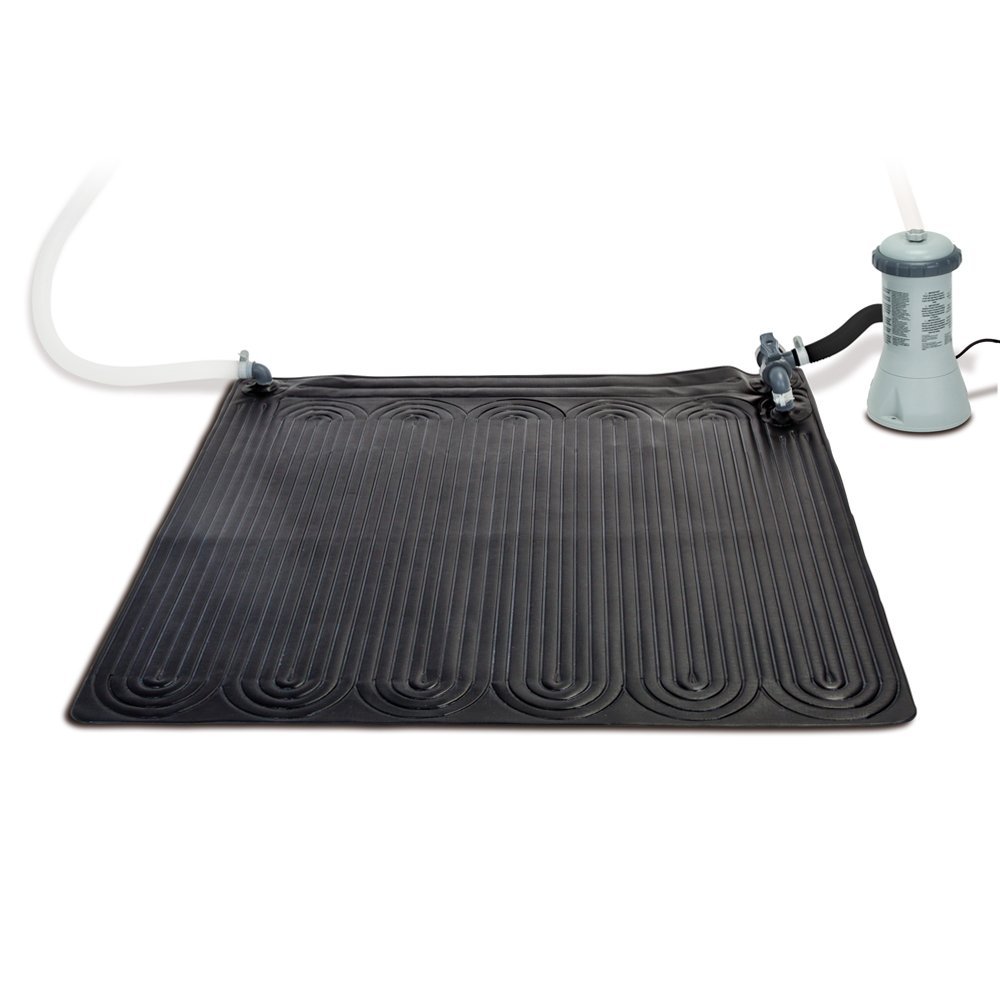
The Intex Solar Heater Mat works with the pool’s filter pump if rated at ½ hp or with a pump water flow rate at 2,500 gallons per hour, or less. These mats work with above ground pools with up to 8,000 gallons of water, or less, with a surface area of 11 square feet (ft sq). The solar mat uses 1¼-inch hose attachment contact points and includes adaptor connection (A and B) for 1½-inch hose connection, if needed. The installation packet also comes with a 1¼-inch connection hose for the bypass valve.
The key feature here is setting them to access the sun throughout the day to keep on building the reservoir of heat, so that it reaches the set temperature and then runs efficiently the rest of the day. You can also add a solar cover over the pool surface to keep heat in, ready for the next day of swimming.
The Intex solar heater mat works with Intex filter pumps, using natural sunlight to warm the pool water by five degrees F to nine degrees F more than the usual water temperature for above ground pools. They work best as an above ground pool heater. At the end of your swimming season, you can dry the mat of any water condensation, then fold it up for storage over the off season.
If you live in California, you should take note of the posted warning concerning California’s Proposition 65, concerning products having certain chemicals known to cause cancer. You can find out more about this information here.
Model #: 28685E
Size: 47.3 inches x 47.3 inches x 0.5 inches
Weight: 5.3 pounds
Efficiency: N/A although customer reports show that it does not cost any more to run it.
Price: Available from 3rd party sellers; range $43.99 (used) to $59.98 new.
What Buyers Say
There are 364 reviews from buyers, giving a total rating of 2.5 stars out of five. It is important to read the Q & A section, as some buyers have come up with solutions for installing this, including buying several to get the heating temperature to the level they want for their pool. One customer in the review section, said he bought 12 mats for his 18-ft round pool with a 52-inche depth of water. The mats were installed on a flat garage roof in three rows of four mats laid across the roof. He then reconfigured his pool outlets and ended up with one large intake for the filter and pump, and two 1¼-inch outlets for the pool. One outlet was routed through the solar layout. Along with a few other adjustments, he also bought a solar cover for the evening hours to help with keeping heat in.
Related: Best Above Ground Pool
You could also use a solar fountain pump, rather than the filter system or bilge pumps, with great success. The solar mats, according to reviews, do not work well with significant water pressure. There were no extra costs with using this type of fountain pump, and they activate when the sun hits the solar panel and turn off when the sun goes down. Another recommendation is to buy sump pump hosing to use with the mats.
Overall, the mats work great although they may take longer to heat the water, especially when using only one. When using several mats, this may be the one way to save money, as opposed to buying more expensive heating solutions.
[su_button url=”https://amzn.to/2ESiNJg” target=”self” style=”flat” background=”#fb8746″ color=”#ffffff” size=”10″ wide=”no” center=”no” radius=”8″ icon=”icon:shopping-cart” rel=”nofollow” class=”bestvacbutton”]Buy Intex Solar Heater Mat for Above Ground Swimming Pool[/su_button]
#3. Kokido Keops Solar Dome Above Ground Swimming Pool Water Heater | K835CBX/RV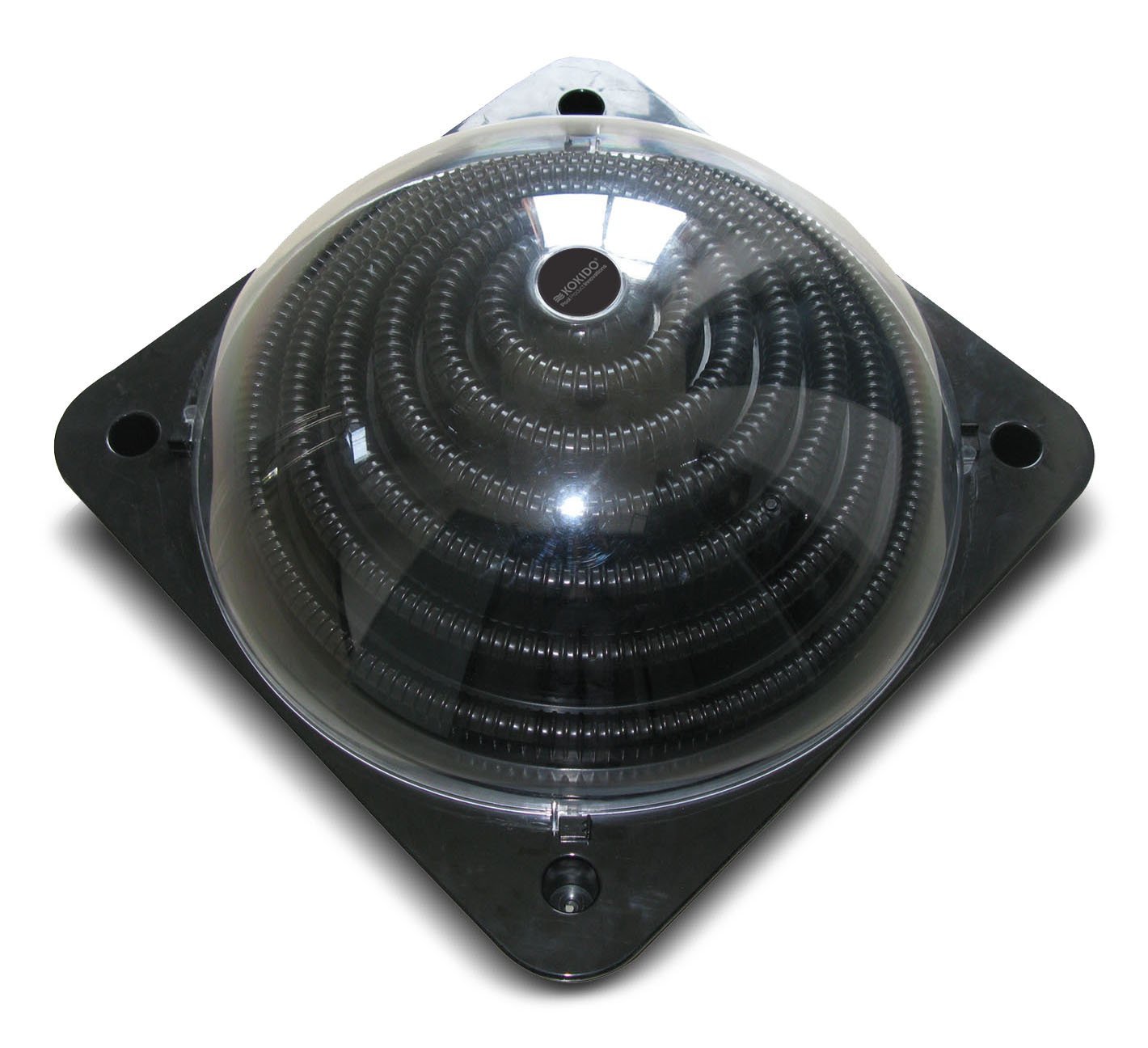
The Kokido Keops solar heating dome for above ground swimming pools is environmentally efficient and is a great way to extend your swimming season. You may wish to buy more than one for added heating capabilities. You also do not have to worry about rooftop installations, but you do still need to make sure that direct sun can reach these domes for greatest energy collection. The water is pumped into the solar heater, circulated through, and passed back into the pool. Here is a chart found on the Amazon product page that shows how many you may need, depending on your pool size.

Consider placing the solar heater(s) at an angle where the collectors can receive direct sunlight, much like the solar mats in the earlier choice. Think through how you will lay the hoses so that water can flow easily from the pool, directly into the solar heater, and back to the pool again. If the water force struggles at either the entrance or exit point, then efficiency in speed of heating may be diminished. Inverted installation racks are included to help point the solar heaters directly at the sun.
Model #: K835CBX/RV
Size: 23 x 11.2 x 23.2 inches
Weight: 14.9 pounds
Efficiency: N/A although you can calculate efficiency the same way as the solar mats.
Price: $132.99 and free shipping
What Buyers Say
This product was rated at three stars out of five, with 21 customers. Reviews are mixed on this product, with some buyers loving them, while others had complaints that the heaters barely made any difference in heating the pool. Make sure you install a good line-of-sight angling of the solar heaters for sun to reach the collectors, and that the hoses allow free direct passage of water to and from the solar heating domes. Keep them as close to the pool water pump as possible. Another complaint was that the hoses provided, were not long enough.
[su_button url=”https://amzn.to/2XJCV7J” target=”self” style=”flat” background=”#fb8746″ color=”#ffffff” size=”10″ wide=”no” center=”no” radius=”8″ icon=”icon:shopping-cart” rel=”nofollow” class=”bestvacbutton”]Buy Kokido Keops Solar Dome Above Ground Swimming Pool Water Heater[/su_button]
#4. SmartPool S120U Universal Sun Heater, 2 by 20-Feet 
The SmartPool S120U is both an above ground pool heater, and an inground pool heater, made with a polypropylene heat collector. It can be laid out anywhere, such as on the ground, but laid at an angle where it catches sun rays during the sun’s transit across the sky. You can also install this on a rooftop as well but consider if your pool pump will give enough energy to pump water up the side of the wall, as it needs more force behind the water going up than coming down.
If you do have a place on the ground where sun shines throughout the day without interference from tall buildings or trees, then you might lay it there and try it out for its heating and circulation capabilities. Just add a slanted rack that is placed on the ground, like the picture above, or you can attach it to a fence to keep it out of the way.
This SmartPool heater has two threaded-elbow adapters, along with two end caps, four stainless steel hose clamps, a roll of Teflon tape, and two extra connector hoses for more solar units. You can buy more than one of these and just connect them together for added heat, depending on the size of your pool. Use a solar cover on your pool to add to solar efficiency and you will have it made, with plenty of heat available during sunny days.
The installation guide is included on this Amazon product page and it has important information you should know up front. If you are doing a roof installation, then choose the south-facing side so the sun hits the solar collectors directly. You will also need the SK-43 mounting kit, essential to use per your warranty, and one of these will secure two SmartPool heater systems. In addition, you may need one SK-34 high wind kit, one for each collector, to keep your collectors safe from blowing away. You can call Smartpool at the following number: 732-730-9880 or check on Amazon to buy them there.
Note that a 1hp water pump gives enough power for installations up to 30 feet away, and one floor up. SmartPool says if the collectors are cool to the touch while water is moving through the collectors, then there is a good water flow.
The extra tools you will need on hand for installation are: a flat-head screwdriver or 5/16-inch (8mm) nut driver, power drill (rack mount or roof install), 1/8-inch (3mm) drill and Phillips head bit, and silicone sealant gel or equivalent. Use a 1½-inch to 2-inch PVC adapter if current plumbing pipe is 2 inches. You also need your measure of 1½-inch (38mm) Schedule 40 PVC pipe that goes to and from your pool. Check the table below to decide how many units you need to heat your size pool.

Model #: S220
Size: 16H x 27.5W x 16L (inches)
Weight: 18 pounds
Efficiency: Figure out the time it takes for one unit to heat the pool, and by how much in degrees. Your variables include amount of daily sun, size of pool, and how strong your water pump is.
Price: $113.99 for Prime Members
What Buyers Say
The SmartPool S120U Universal solar heater received 11 reviews and three stars. Several buyers like this solar heater, although some had to get a second unit and install it, as well as adding a solar cover. This is usually due to larger pool surfaces. There are issues with fittings and water leaks, which can be problematic, but might be solved with the silicone gel or PVC primer.
You can also use this for a salt water pool but may need to clean it periodically. Another pointer is that this does not come with a stand, so you will need to make one if you plan to angle it on the ground. Make sure it is secured so it stays in place during heavy winds.
[su_button url=”https://amzn.to/2UrcwJW” target=”self” style=”flat” background=”#fb8746″ color=”#ffffff” size=”10″ wide=”no” center=”no” radius=”8″ icon=”icon:shopping-cart” rel=”nofollow” class=”bestvacbutton”]Buy SmartPool S120U Universal Sun Heater[/su_button]
#5. GAME 4721 SolarPRO Curve Solar Pool Heater for Intex & Bestway Above Ground and in Ground Pools (Includes Intex Adapters)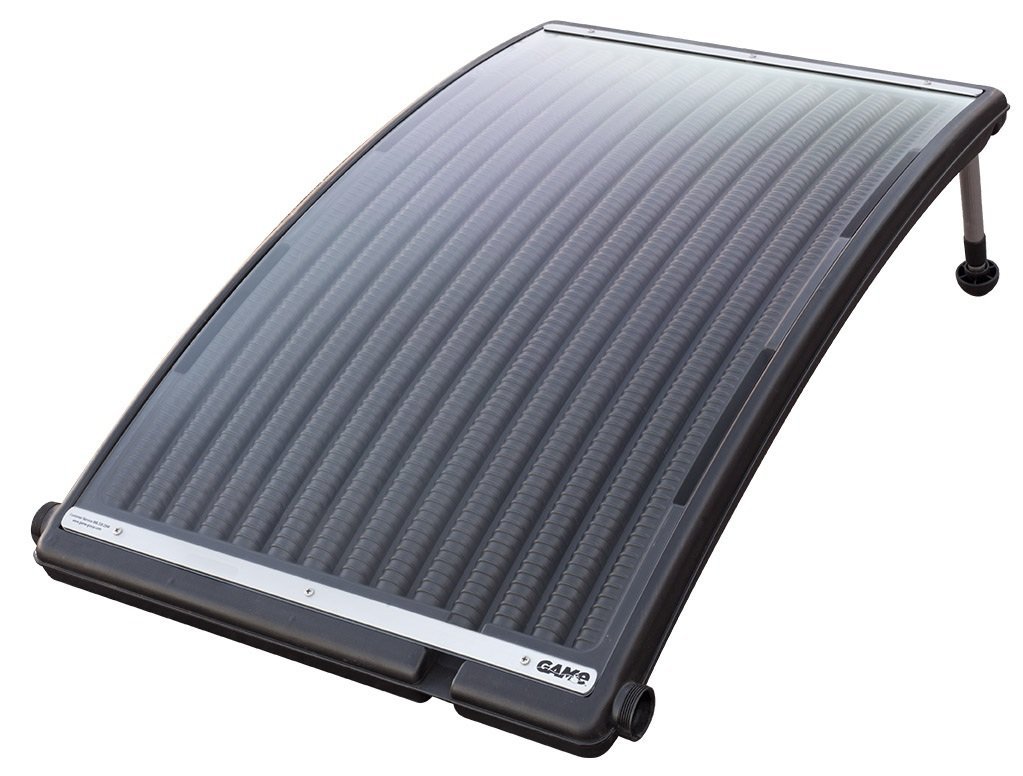
The GAME SolarPRO CURVE is made to attach to both an in-ground or above-ground pool and comes with all the adapters and hoses needed for the hookup. You can add more units as needed. This solar heater is made with a blow-molded plastic frame with clear cover, to lock in the heat and reduce cooling wind flows. It fits best with the Intex and Bestway pool brands, although you may be able to use it with other brands, with some modifications.
As with other solar heaters, it is slow to heat, but heating temperatures will rise five degrees over four days. If using more than one unit, you may have a higher outcome sooner. The ports are threaded, and the kit includes two hoses with stainless steel hose clamps. The image below shows one way of setting this unit up by the above-ground pool.

Model #: 4721
Size: 43.3 x 9.4 x 27.2 inches
Weight: 18.3 pounds
Efficiency: Figure out the time it takes for one unit to heat the pool, and by how much in degrees. Your variables include amount of daily sun, size of pool, and how strong your water pump is.
Price: $142.99
What Buyers Say
This GAME 4721 SolarPRO Curve Solar Pool Heater has received 253 reviews and a 2.5-star rating. In the Q & A section, most buyers say this is very easy to install yourself, and if you are elderly, or have physical issues, have somebody you know well, install it for you. In exchange, you could offer a day or more of swimming privileges.
One person mentioned that they let the heater run all day long when the sun was shining and had to cover the heater at one point, so as not to have a hot tub instead. Consider adding a solar cover to keep in the heat overnight. He also mentioned that the hoses are not long, which may be a problem if the installation must be further away from the pool.
A common complaint, however, was that once leaks started from the connections, it was hard to stop it. If in doubt, have a professional do the installation to ensure there are no leaks.
[su_button url=”https://amzn.to/2XDKehk” target=”self” style=”flat” background=”#fb8746″ color=”#ffffff” size=”10″ wide=”no” center=”no” radius=”8″ icon=”icon:shopping-cart” rel=”nofollow” class=”bestvacbutton”]Buy GAME 4721 SolarPRO Curve Solar Pool Heater[/su_button]
#6. Thermo-Tex 2831224 Swimming Pool Solar Pool Cover, 12′ x 24′, Blue
The Thermo-Tex swimming light weight solar pool cover helps extend your swimming season by a month or more, and in combination with another solar heater already spoken of here, the season can be extended several months more.
Using a solar cover, such as this one, also reduces chemical consumption, heating costs, and water loss from evaporation. This cover is made from UV stabilized polymers, designed to resist degradation typically caused by extended periods with pool chemicals, combined with sun exposure. There is a three-year warrantee and it is made on the North American continent.
This pool cover is specifically made to cover the water’s surface in-ground pools and is easy to pull off the surface whenever needed.
Model #: 2831224
Size: 24 inches x 12 inches x 1 inch
Weight: 9 pounds
Efficiency: Test cover efficiency by getting water temperature first, before using the cover. Test it under several weather conditions as well, for a full overview of efficiency, and with another solar heater in use.
Price: $39.00 for 12 feet x 24 feet (rectangle)
What Buyers Say
This solar blanket with bubbles has received four stars out of five, with 39 buyers giving a review on its use. This solar cover behaves like a blanket of bubble wrap, although you do not want to pop the ¾-inch bubble cells in this product. You can, however, add grommets where applicable, if you wish to use it on an in-ground swimming pool, or if it extends over the edges, just weigh it down with bricks to avoid having it blow away in high winds. Just be sure to put the bubbles face down over the pool, as that helps with heat distribution. You can also cut it to pool shape if you wish.
Even getting one year’s worth of use is a big plus, as it works very well in giving solar heat. However, pool chemicals can take a toll over time, unless you can care for it better by rinsing it off every time it is pulled off the pool water. That may help extend the cover’s life span.
This cover works well, even if it has to be replaced every one to two years, despite the 3-year warrantee. The most positive aspect is that when the pool heats up during the day, and the cover was added in the evening, there was little heat loss when the pool was uncovered the next day. This is a great bargain for the price, and even better when used with another solar power application.
[su_button url=”https://amzn.to/2XGMMve” target=”self” style=”flat” background=”#fb8746″ color=”#ffffff” size=”10″ wide=”no” center=”no” radius=”8″ icon=”icon:shopping-cart” rel=”nofollow” class=”bestvacbutton”]Buy Thermo-Tex 2831224 Swimming Pool Solar Pool Cover[/su_button]
#7. Pentair 461059 Master Temp 125K, BTU Heater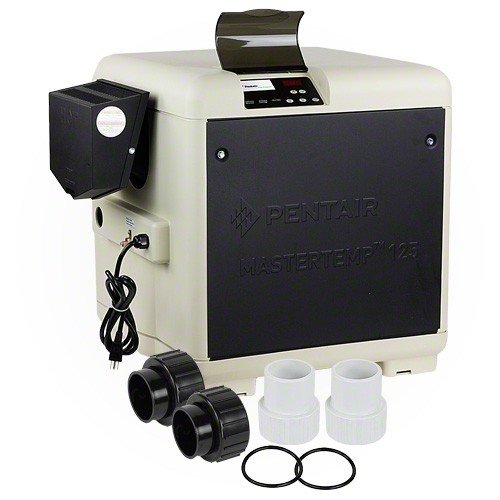
The Pentair Master Temp 125K BTU natural gas pool heater is an affordable heater, with a rating of 82 percent thermal efficiency, considered the highest performing heater in this category. It has a 1.5-inch plumbing arrangement and heats up to 15,000 gallons of water. The premixed combustion technology gives an ultra-fast heating time for the water to reach desired temperature. This heater uses a rotating digital display, giving easy access to programming and checking the unit as needed. It is certified for low-NOx emissions and for outdoor and indoor-vented installations.
This is a well-designed unit that is simple and convenient to use. According to the manufacturer’s website, it is the first offered on the market in its class, and advanced features gives you more control and information on the unit’s status. It also would be worth your while to check local codes and regulations, and to have a professional install it for you. You can find the warranty and the installation instructions on this Amazon product page. Just click on the title link.
Model #: 461059
Size: 39 x 27 x 25 inches
Weight: a hefty 150 pounds
Efficiency: 82 percent
Price: $1,061.31
What Buyers Say
There is just one five star review for this pool heater at the time of writing this. In the Q & A section, there are some important notes given, such as you will need a ¾-inch gas line for the installation. If you do not have gas service, you cannot use this unit. The heat exchanger material is made of copper, which is a good conductor. You can also check with the manufacturer as to whether this can be changed to run on propane. One customer said yes, but it is always wise to check first with the manufacturer and a professional. This is a very good heating unit to use if you have the budget for it.
[su_button url=”https://amzn.to/2ESySi4″ target=”self” style=”flat” background=”#fb8746″ color=”#ffffff” size=”10″ wide=”no” center=”no” radius=”8″ icon=”icon:shopping-cart” rel=”nofollow” class=”bestvacbutton”]Buy Pentair 461059 Master Temp 125K, BTU Heater[/su_button]
Water Maintenance – Shock Your Pool
It is so important to take care of your pool water on a regular schedule. A major part of supporting healthy clear water is to shock your pool. Your water needs to have a balance of chlorine, pH, and alkalinity, especially if you are warming your water with a pool heater. If you lapse on controlling your pool water’s needed mixture, your swimming water will begin growing algae and turn green and cloudy.
Shocking a pool entails adding excess chlorine to sanitize the water, killing any bacteria and getting rid of contaminants. If your water is turning cloudy, then it is time to get this done. You must first know the size and volume of your pool to get ready for this procedure. If you have 10,000 gallons of water (volume) in your pool, then you will need one or two pounds of shock.
First, measure the water’s pH, which should be between 7.2 to 7.6, with alkalinity between 80 and 120 parts per million (ppm). Should you find that you have a measure of total alkalinity (TA), a major out-of-balance situation, then you need to get it back down to the measure given earlier. Add Muriatic Acid, based on your volume, and then let your water “air out” or aerate naturally, without using any spa jets, air compressors, or other active procedures that need forced water movement. If in doubt of what to do, call a pool professional to help you with this.
If you have been using a pool heater, turn it off and get the temperature down to the level it normally would be without the heater. Do not use your solar cover either. Right before applying the shock treatment, make sure that you clear any leaves and other debris out of the pool beforehand. If there have been heavy rains, then drain the water until it reaches its regular level in the pool.
Make sure your pool water is at its regular level in the pool, then prepare your shock treatment, which can be chlorine or a non-chlorine product. In some cases, you may need to mix your treatment with warm water to fully dissolve it. Fill your container with the warm water and add treatment a bit at a time and stir it as you go. Usually a bucket with five gallons of warm water will work.
Walk around the pool edge while evenly distributing the shock treatment until you have none left. Next, you run your filtration pool pump for 24 hours to get rid of the pool’s contaminants by passing that water out of your pool’s system. It also cleans the pool pump as well.
If using a chlorine-based treatment, wait at least eight hours before getting into the pool. The chlorine concentration should be 3 ppm or less, before you get in. Beware; a high chlorine content can be dangerous to your health. If you have sensitivities to chemicals, try a non-chlorine product. If you use a non-chlorine treatment, you only need 15 minutes to wait before getting in to the pool water.
Ideally, it is best to shock the pool in the evening hours, when there is little to no sunshine left, otherwise direct sun will reduce your chlorine treatment’s effectiveness. DO NOT run your pool’s heating system until after the pool pump has run for 24 hours. You may have to disconnect it to avoid any chances of heating up, such as with solar heating systems.
How Often to Shock Your Pool
If you are swimming daily and if other people are swimming in the pool too, then you may want to do this treatment once a week. Otherwise, every two weeks will work fine. Using heating systems for warmer water, means you must do this at least every two weeks, or sooner. You can regularly test your water to see how its composition changes over time while using the heating system.
Free chlorine is the standard term for what should be in your pool and the measure should be a constant 3 ppm to keep your pool water clean. The combined chlorine (chloamine) is a measure of a combination, aside from free chlorine, of other properties that get into the pool water, such as body oils, sweat, urine, suntan lotions, and other undesired properties. When the combined chlorine measure is high, then free chlorine has less of a chance to keep your water clean.
The total chlorine measure is a combination of both free chlorine and combined chlorine properties. Develop a regular schedule of testing the water to keep up with any problems that are developing, particularly if you use a heating system on a regular basis.
Use a Professional Water Testing Kit
You can find several professional water testing kits, either at your local big box store or on Amazon, that will help greatly in getting all the right measurements you need to know what steps you must take next.
If you are new to managing your pool water, have a professional pool person come in for the first time or two, and learn from them how to do it yourself. You can check prices for pool maintenance schedules done by pool professionals, if you have little time to spend on this yourself. Whichever way you decide, you must set up a regular schedule to avoid unhealthy situations, especially when using pool heaters.
Between using your pool heater of choice and conducting regular water maintenance procedures, you will enjoy using your pool for a long time to come.
